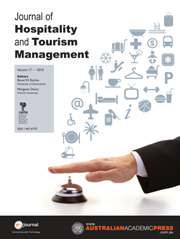Crossref Citations
This article has been cited by the following publications. This list is generated based on data provided by
Crossref.
Kerr, Greg
and
Oliver, Jessica
2015.
Rethinking Place Branding.
p.
61.
Guttentag, Daniel
Smith, Stephen
Potwarka, Luke
and
Havitz, Mark
2018.
Why Tourists Choose Airbnb: A Motivation-Based Segmentation Study.
Journal of Travel Research,
Vol. 57,
Issue. 3,
p.
342.
Zhang, Elaine Yulan
and
Tse, Tony S. M.
2018.
Tapping into Chinese Luxury Travelers.
Journal of China Tourism Research,
Vol. 14,
Issue. 1,
p.
71.
Speake, Janet
and
Kennedy, Victoria
2019.
'Buying' into the waterfront dream? Trajectories of luxury property led developments in Malta.
Tourism Management,
Vol. 71,
Issue. ,
p.
246.
Moital, Miguel
Bain, Amy
and
Thomas, Harriet
2019.
Summary of cognitive, affective, and behavioural outcomes of consuming prestigious sports events.
Sport Management Review,
Vol. 22,
Issue. 5,
p.
652.
Liu, Hongbo
Wu, Laurie
and
Li, Xiang (Robert)
2019.
Social Media Envy: How Experience Sharing on Social Networking Sites Drives Millennials’ Aspirational Tourism Consumption.
Journal of Travel Research,
Vol. 58,
Issue. 3,
p.
355.
Tosun, Petek
and
Öksüz, Merve
2019.
Destination Personalities of Alacati and Ayvalik in Turkey: Consumer Perceptions of a Summer Holiday.
Journal of Yaşar University,
Vol. 14,
Issue. ,
p.
82.
Chen, Feier
Liu, Stephanie Q.
and
Mattila, Anna S.
2020.
Bragging and humblebragging in online reviews.
Annals of Tourism Research,
Vol. 80,
Issue. ,
p.
102849.
Palmer, Alicia
Amaro, Suzanne
and
Andreu, Luisa
2020.
Advances in Tourism, Technology and Smart Systems.
Vol. 171,
Issue. ,
p.
67.
Liu, Hongbo
and
Li, Xiang (Robert)
2021.
How Travel Earns Us Bragging Rights: A Qualitative Inquiry and Conceptualization of Travel Bragging Rights.
Journal of Travel Research,
Vol. 60,
Issue. 8,
p.
1635.
Kostopoulos, Ioannis
Magrizos, Solon
and
Harris, Lloyd C.
2021.
Tourists as Experience Collectors: Conceptualizing the Process of Collecting.
SSRN Electronic Journal ,
Downs, Craig A.
Cruz, Orion T.
and
Remengesau, Tommy E.
2022.
Sunscreen pollution and tourism governance: Science and innovation are necessary for biodiversity conservation and sustainable tourism.
Aquatic Conservation: Marine and Freshwater Ecosystems,
Vol. 32,
Issue. 5,
p.
896.
Xi, Yue
Huo, Jiale
Zhao, Xinran
Jiang, Yushi
and
Yang, Qiang
2022.
The effects of fear of missing out on social media posting preferences.
European Journal of Marketing,
Vol. 56,
Issue. 12,
p.
3453.
Li, Monica Z.
and
Stodolska, Monika
2022.
Beyond luxury consumption: The meaning and meaning-making mechanism in conspicuous outbound tourism.
Journal of Leisure Research,
Vol. 53,
Issue. 5,
p.
687.
Asdecker, Björn
2022.
Travel-Related Influencer Content on Instagram: How Social Media Fuels Wanderlust and How to Mitigate the Effect.
Sustainability,
Vol. 14,
Issue. 2,
p.
855.
Pratt, Stephen
and
Tolkach, Denis
2022.
Stupidity in tourism.
Tourism Recreation Research,
Vol. 47,
Issue. 1,
p.
3.
Silanoi, Tongrawee
Meeprom, Supawat
and
Jaratmetakul, Porramate
2022.
Consumer experience co-creation in speciality coffee through social media sharing: its antecedents and consequences.
International Journal of Quality and Service Sciences,
Vol. 14,
Issue. 4,
p.
576.
2022.
Practical Peer-to-Peer Teaching and Learning on the Social Web.
p.
316.
Sharma, Rashmini
Singh, Gurmeet
and
Pratt, Stephen
2022.
Exploring travel envy and social return in domestic travel: a cross-generational analysis.
Journal of Travel & Tourism Marketing,
Vol. 39,
Issue. 1,
p.
58.
Liu, Hongbo
Li, Xiang (Robert)
and
Cohen, Scott
2023.
Is travel bragging in the eye of the beholder? Bragger and audience perspectives.
International Journal of Tourism Research,
Vol. 25,
Issue. 5,
p.
475.




